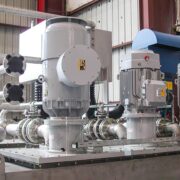Artificial intelligence (AI) is one of the latest technological advances being used in nearly every industry. The full scope and range of Its applications are still in its infancy stage but are making promising advancements in the new era of COVID-19. Victor Restis, president of Enterprises Shipping & Trade S.A., says there are ongoing tests and implementations of robotics that are providing speed, efficiency, and proficiency to one of the world’s most important industries, international shipping, trade, and supply chains. As the industry begins to emerge out of COVID, advanced robotics are influencing a vast array of maritime operations. Influenced heavily by a global mandate to significantly decrease carbon emissions in the next 30 years, bionics are providing green and eco-friendly benefits. From regular hull cleanings to anti-piracy measures, robotics is providing vast applications.
Restis points out that the maritime industry loves to test new technologies and are doing so today with exciting results. The one area yet to be practiced, but being tested, is replacing humans onboard transoceanic cargo vessels. Today, several companies are experimenting with robotics to assist human resources. Once self-driving cars and planes become the “norm” the maritime industry may feel more comfortable experimenting more with this level of AI-driven robotic technology.
In the meantime, the use of robotics during hazardous or potentially dangerous situations is becoming more frequent. In these scenarios, replacing human laborers with robotics allows a safer and more streamlined operation. For example, robotics aboard oil clean-up vessels replaces human resources keeping them safe during potentially dangerous situations. Using robotics for oil spill clean-up eliminates human exposure to hazardous chemicals, toxic fumes, and a high risk for fire or explosions. Robotics can also safely interface with humans and other AI machines without the risk of infection form virus, or the common cold.
For example, Shipboard Autonomous Fire Fighting Robot (SAFFiR), developed by Naval Research Laboratory in collaboration with Virginia Tech and other US universities, created an autonomous humanoid robot capable of detecting and suppressing shipboard fires while working shoulder to shoulder with human firefighters. The idea behind this technological advancement for now is not to replace humans in firefighting operations but to provide much needed assistance.
Ship inspections are also being moved out of human hands and placed under the scope of work for robotics. All vessels are required to undergo various levels of inspections while in service. The time of an “out of service” vessel is a significant expense setback for many shipping companies. Cargo vessels are notoriously difficult to inspect, and inspectors face a litany of challenges in accurately detecting any cracks, corrosion, or other serious complications. Robotics could be the answer to quickly and effectively inspect a large vessel, provide areas of needed improvements, and get the vessel back into circulation quicker.
According to Restis, if robotic technology can increase maritime safety, proficiency, and delivery time, then it’s definitely in the best interest of companies to explore and continue testing these technological advancements. Though robotics and other AI technologies can perform and help in many crucial jobs, it would be challenging for them to replace the experience, knowledge, and skills that seafarers bring to the industry. The future of global shipping and trade post COVID-19 requires a healthy balance between robotization and seafarers’ efforts. With the overall goal of enhancing the quality and safety of shipboard work, robotics can make a difference in the industry overall.


















Comments